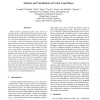Free Online Productivity Tools
i2Speak
i2Symbol
i2OCR
iTex2Img
iWeb2Print
iWeb2Shot
i2Type
iPdf2Split
iPdf2Merge
i2Bopomofo
i2Arabic
i2Style
i2Image
i2PDF
iLatex2Rtf
Sci2ools
BIBE
2006
IEEE
2006
IEEE
Isolation and Visualization of Codon Usage Biases
While genomic sequencing projects have proved an abundant source of information for biological studies ranging from the molecular to the ecological in scale, much of the information present may yet be hidden from casual analysis. One such information source, trends in codon usage, can provide a wealth of information about an organism’s genes and their expression. Degeneracy in the genetic code causes more than one codon to code for the same amino acid, and usage of these codons is often biased such that one or more of these synonymous codons is preferred. Detection of this bias is an important tool in the analysis of genomic data, particularly as a predictor of gene expressivity. There are many algorithmic methods for identifying bias in genomic data, all of which are susceptible to being obscured by the presence of factors simultaneously influencing codon selection. Presented here is a new technique for removing the effects of confounding factors and of visualizing the bias data t...
BIBE 2006 | Bioinformatics | Codon | Codon Usage | Genomic Data |
| Added | 10 Jun 2010 |
| Updated | 10 Jun 2010 |
| Type | Conference |
| Year | 2006 |
| Where | BIBE |
| Authors | Douglas W. Raiford, Dan E. Krane, Travis E. Doom, Michael L. Raymer |
Comments (0)

